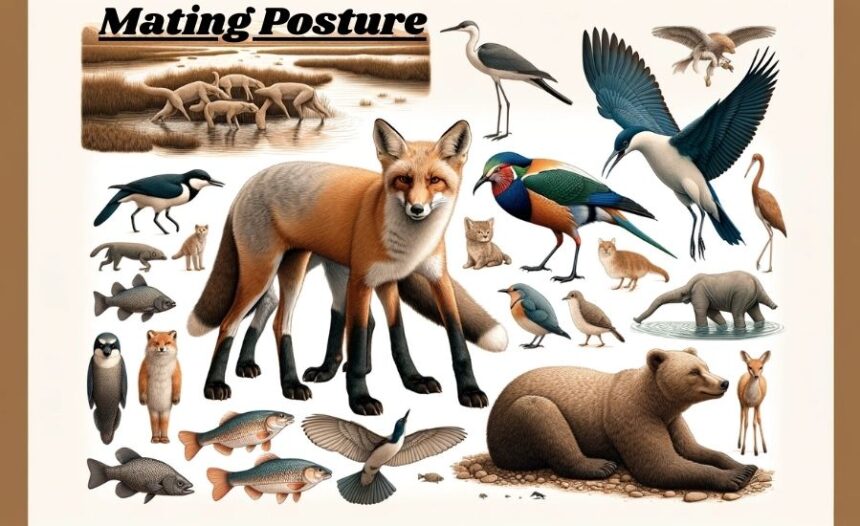Introduction to Mating Posture
Mating posture refers to the specific physical positions that animals assume during copulation. These postures vary widely across the animal kingdom and are influenced by anatomical, behavioral, and evolutionary factors. Understanding these postures not only provides insight into the reproductive strategies of various species but also highlights the complexity of sexual selection mechanisms that operate in nature.
What is Mating Posture?
Mating posture, or copulatory position, is crucial in the animal mating process. It ensures that both males and females align their reproductive organs in such a way that maximizes the potential for successful fertilization. The choice of posture can be affected by physical compatibility, predator presence, and the need for quick and effective mating.
Exploring Mating Posture Across Different Species
Insect Mating Posture
Insects exhibit some of the most diverse mating postures. For example, dragonflies and damselflies form a mating wheel, where the male grasps the female by the neck while she arches her body to receive sperm from the male’s secondary genitalia.
Bird Mating Posture
Birds, particularly those with complex mating rituals like many waterfowl, often have aggressive mating postures that can include forceful grasping by the male. The posture is designed to stabilize the pair during copulation, which often takes place on water.
Mammalian Mating Posture
In mammals, mating posture can be dictated by size differences between sexes or by the need for quick mating to avoid predation. Canines, for instance, are known for the ‘copulatory tie,’ where the male and female end up locked together, increasing the chances of successful sperm transfer.
Aquatic Life Mating Posture
Fish and aquatic mammals may engage in synchronized swimming patterns or use belly-to-belly positions to ensure close alignment of reproductive organs during the brief mating encounter.
Feline Mating Posture: A Case Study
Cats have a distinctive mating posture that is an excellent case study of animal behavior and evolutionary adaptation. During mating, the female assumes a lordosis position—she crouches on her front limbs, raises her hindquarters, and tilts her tail to one side. This posture facilitates easier access for the male, who mounts from behind and often bites the neck of the female to hold her in place. The induced ovulation in cats, where the act of mating stimulates the release of eggs, complements this posture by maximizing the chances of fertilization.
Advanced Insights into Mating Posture
The Role of Physiology in Mating Posture
The physical structure of reproductive organs plays a critical role in determining the mating posture of an animal. In many bird species, for example, mating posture must accommodate the unique spiral-shaped cloaca.
Evolutionary Implications of Mating Posture
From an evolutionary perspective, certain mating postures may better facilitate sperm competition or protect the female from injuries during mating, influencing sexual selection and reproductive success.
Ethological Theories on Mating Posture
Ethologists believe that mating posture may evolve due to various pressures such as predation, where quicker, more efficient postures may offer evolutionary advantages by reducing the vulnerability of the mating pair.
Visualizing Mating Posture
Diagrams and high-quality images of animals in various mating postures can provide visual substantiation to the descriptions in the article, aiding in better understanding and retention of the information presented.
Conclusion: The Diversity and Complexity of Mating Posture
The study of mating posture offers fascinating insights into the reproductive strategies of animals. By examining the physical and behavioral aspects of mating posture, researchers can gain a deeper understanding of the evolutionary pressures that shape sexual behavior across species.
Further Exploration: Questions on Mating Posture
What is the primary purpose of specific mating postures in animals?
To align reproductive organs optimally for fertilization and to ensure that mating is successful within the ecological context of the species (e.g., predator presence).
How does the mating posture of a dragonfly contribute to its reproductive success?
The wheel formation in dragonflies allows for close genital contact and prolonged mating, increasing the chances of successful sperm transfer.
Why do some birds have aggressive mating postures?
Aggressive postures can ensure that the male maintains contact with the female amid environmental challenges, such as floating on water, which is common among waterfowl.
What role does anatomy play in determining mating posture in cats?
Cats’ flexible spine and the female’s ability to raise her hindquarters are anatomical adaptations that facilitate the lordosis posture for easier male access.
How might mating posture evolve in the future for species currently under environmental stress?
Future changes in mating posture might involve adaptations that reduce the time exposed to predators or adjust for physical changes in habitat that affect how animals can physically mate.
By exploring these questions and integrating visual aids, this article not only educates but also engages readers with the complex world of animal mating behaviors.







